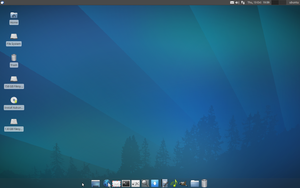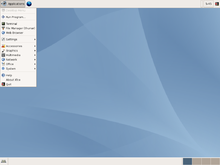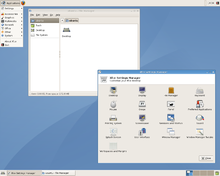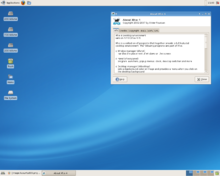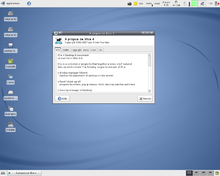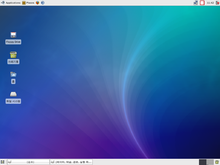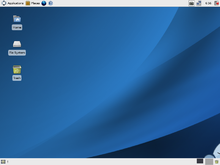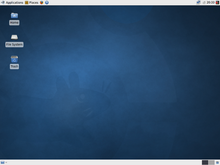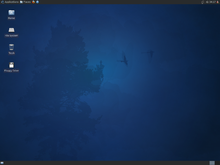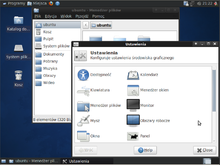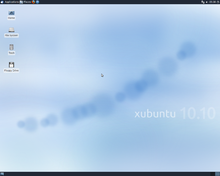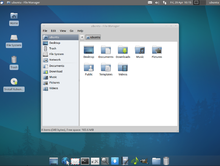| LinuxPlace.net the Linux Place on the Net |
Xubuntu
By Wikipedia, the free encyclopedia
http://en.wikipedia.org/wiki/Xubuntu
Xubuntu (/zuːˈbuːntuː/ zoo-boon-too) is a Canonical Ltd. recognized, community maintained derivative of the Ubuntu operating system, using the Xfce desktop environment.
The name Xubuntu is a portmanteau of Xfce and Ubuntu. Xfce originally was an abbreviation for XForms Common Environment, while Ubuntu means "humanity towards others" in the Zulu and Xhosa languages.
Goals
Xubuntu's goals are to:
provide an easy to use distribution, based on Ubuntu, using Xfce as the graphical desktop, with a focus on integration, usability and performance, with a particular focus on low memory footprint. The integration in Xubuntu is at a configuration level, a toolkit level, and matching the underlying technology beneath the desktop in Ubuntu. Xubuntu will be built and developed autonomously as part of the wider Ubuntu community, based around the ideals and values of Ubuntu.
The Xfce desktop environment is intended to use fewer system resources than the default Ubuntu Unity desktop. As recently as September 2010 the Xubuntu developers claimed that the minimum RAM Xubuntu could be run on was 128 MB, with 256 MB of RAM strongly recommended at that time.
Testing conducted by Martyn Honeyford at IBM in January 2007 on Xubuntu 6.10 concluded that it "uses approximately 25 MB less application memory, and also eats significantly less into buffers and cache (which may imply that there is less file activity) than Ubuntu."
Later testing showed that Xubuntu was at a disadvantage compared to Debian equipped with the Xfce desktop. Tests were conducted by DistroWatch on a Dell Dimension 4500 desktop machine, with an Intel 2 GHz processor and 384 MB of memory in April 2009, that compared Xubuntu 9.04 against an Xfce desktop version of Debian 5.0.1. These showed that Xubuntu used more than twice the RAM as Debian in simple tasks. Xubuntu also ran out of RAM doing everyday tasks, indicating that 384 MB of RAM was inadequate. The review concluded "It was obvious I had already run out of RAM and was starting to use swap space. Considering I wasn't doing very much, this was rather disappointing". Subsequent experimentation by Distrowatch concluded that the performance advantages observed in Debian were due to Xubuntu's inclusion of memory-hungry software not present in Debian's implementation of Xfce.
Testing conducted on a later version, Xubuntu 9.10 beta, in September 2009 showed similar results. The tests, conducted by Linux Magazine, concluded that Xubuntu 9.10 beta's RAM usage was actually greater than Ubuntu's 9.10 beta with GNOME.
Subsequent reviewers emphasized Xubuntu's perceived deficiencies in performance to highlight Lubuntu, a project with similar goals but using the LXDE desktop environment as opposed to Xfce. For instance, Damien Oh of Make Tech Easier noted in May 2010, "So what about Xubuntu? isn’t it supposed to be the lightweight equivalent of Ubuntu? Sadly, that is a thing of the past. The truth is, the supposed lightweight equivalent is not lightweight at all. While Xubuntu is using the lightweight XFCE desktop environment, it had been bugged down by several heavyweight applications and also the integration with GNOME desktop also makes it lose its advantage."
As of the Xubuntu 11.04 release the developers now "strongly recommend" 512 MB of RAM to use Xubuntu. This is the same as is recommended for Ubuntu 11.04.
History
Xubuntu was originally intended to be released at the same time as Ubuntu 5.10 Breezy Badger, 13 October 2005, but the work was not complete by that date. Instead the Xubuntu name was used for the xubuntu-desktop metapackage available through the Synaptic Package Manager which installed the Xfce desktop.
The first official Xubuntu release, led by Jani Monoses, appeared on 1 June 2006, as part of the Ubuntu 6.06 Dapper Drake line, which also included Kubuntu and Edubuntu.
Cody A.W. Somerville developed a comprehensive strategy for the Xubuntu project named the Xubuntu Strategy Document. In early 2009 the document was awaiting a second reading by the Ubuntu Community Council.
In February 2009 Mark Shuttleworth agreed that an official LXDE version of Ubuntu, Lubuntu, would be developed. The LXDE desktop uses the Openbox window manager and, like Xubuntu, is intended to be a low-system-requirement, low-RAM environment for netbooks, mobile devices and older PCs and will compete with Xubuntu in that niche.
In November 2009, Cody A.W. Somerville stepped down as the project leader and made a call for nominations to help find a successor. Lionel Le Folgoc was confirmed by the Xubuntu community as the new project leader on 10 January 2010 and requested the formation of an official Xubuntu council. As of late March 2010, discussions regarding the future of Xubuntu's governance and the role a council might play in it were still ongoing.
Xubuntu 6.06 LTS
The first official stand-alone release of Xubuntu was version 6.06 Long Term Support (LTS), which was made available on 1 June 2006.
It was introduced with the statement "Xubuntu is the newest official Ubuntu derivative distribution, using the Xfce desktop environment and a selection of GTK2 applications. Its lightweight footprint is well suited for low-end hardware and thin clients. Xubuntu builds on the solid foundation of Ubuntu, with world-class hardware support and access to a vast repository of additional software."
The version used Linux kernel 2.6.15.7 and Xfce 4.4 beta 1. Applications included the Thunar file manager, GDM desktop manager, Abiword word processor and Gnumeric spread sheet, Evince PDF document viewer, Xarchiver archive manager, Xfburn CD burner, Firefox 1.5.0.3 web browser, Thunderbird 1.5.0.2 email client and the GDebi package manager.
Caitlyn Martin reviewed Xubuntu 6.06 in June 2006. She singled out its "bare bones approach" to the applications included, indicating that she would rather add applications she wanted than clean out ones she didn't want. On her aging laptop Xubuntu 6.06 proved faster than Fedora Core 5. She stated "Under Fedora when I opened a couple of rather resource intensive applications, for example Open Office and Seamonkey, the system would begin to drag. While these apps still take a moment to get started on Xubuntu they are crisp and responsive and don’t seem to slow anything else down. I never expected this sort of performance and that alone made Xubuntu an instant favorite of mine." She had praise for the Thunar file manager, as light and fast. She concluded "Overall I am impressed and Xubuntu, for the moment anyway, is my favorite Linux distribution despite a few rough edges, probably largely due to the use of a beta desktop."
Xubuntu 6.10
Xubuntu 6.10 was released on 26 October 2006. This version used Xfce 4.4 beta 2 and included Upstart, the Firefox 2.0 web browser, the Gaim 2.0.0 beta 3.1 instant messaging client along with new versions of AbiWord and Gnumeric. The media player was gxine which replaced Xfmedia. The previous xffm4 file manger was replaced by Thunar. It introduced redesigned artwork for the bootup splash screen, the login window and the desktop theme.
The developers claimed that this version of Xubuntu could run on 64 MB of RAM, with 128 MB "strongly recommended".
Reviewer Caitlyn Martin tested Xubuntu on a four year old Toshiba Satellite 1805-S204 laptop, with a 1 GHz Celeron processor and 512 MB of RAM in December 2006. She noted that Xubuntu ran faster than GNOME or KDE, which she described as "sluggish" and rated it as one of the two fastest distributions on her limited test hardware, placing with Vector Linux. She found the graphical installer to be be less than acceptable and the text-based installer better. She concluded, "Once I had everything I like installed and configured I’ve found Xubuntu to be truly a pleasure to use. It’s user friendly for the newcomer and highly customizable for the experienced user. The basic application set on the single CD is, as expected, limited but I’d rather build up a distro with what I need and exclude what I don’t need than try to remove cruft. Performance is the best I’ve seen in any current distro. Most of my complaints are nitpicking and in general Xubuntu Edgy Eft is as good as any Linux distribution I’ve used so far. Highly recommended."
Xubuntu 7.04
Xubuntu 7.04 was released on 19 April 2007. This release was based on Xfce 4.4.
Michael Larabel of Phoronix carried out detailed benchmark testing of betas for Ubuntu 7.04, Kubuntu 7.04 and Xubuntu 7.04 in February 2007 on two different computers, one with dual Intel Clovertown processors and the other with an AMD Sempron. After a series of gzip compression, LAME compilation, and LAME encoding tasks he concluded, "in these tests with the dual Clovertown setup we found the results to be indistinguishable. However, with the AMD Sempron, Ubuntu 7.04 Feisty Fawn Herd 4 had outperformed both Kubuntu and the lighter-weight Xubuntu. Granted on a slower system the lightweight Xubuntu should have a greater performance advantage."
In one Review Linux look at Xubuntu 7.04 it was faulted for not including OpenOffice.org. The reviewer noted "If you do decide to keep the default software, it will cover your basic needs. Xubuntu comes with light weight desktop in XFCE 4.4 and also less tasking programs. If you are thinking that OpenOffice will come pre-installed on your desktop, you will be greatly surprised as AbiWord and Gnumeric are your default processor and spreadsheet program." He indicated though that installing applications from the repositories was easy and made for simple customization of an installation.
Xubuntu 7.10
18 October 2007 was the release date for Xubuntu 7.10. It was based upon Xfce, 4.4.1 and added updated translations along with a new theme, MurrinaStormCloud, using the Murrine Engine.
Application updates included Pidgin 2.2.0, (Gaim was renamed Pidgin) and GIMP 2.4. This Xubuntu version allowed the installation of Firefox extensions and plug-ins through the Add/Remove Software interface.
The developers claimed that this version of Xubuntu could run on 64 MB of RAM, with 128 MB "strongly recommended".
In a review of the release candidate for Xubuntu 7.10 that was installed on a Pentium 2 300 Celeron with 256 MB of RAM, equipped with an nVidia GeForce 4 64 MB video card, Review Linux noted that "the system was very fast".
Review Linux positioned Xubuntu and its role, "The main difference between Xubuntu and Ubuntu is the fact that Xubuntu is a little lighter on system requirements and it uses Xfce as it's (sic) desktop. Xubuntu is perfect for that old computer just lying around in your basement."
Xubuntu 8.04 LTS
Xubuntu 8.04 Long Term Support (LTS) was made available on 24 April 2008. This version of Xubuntu used Xfce 4.4.2, Xorg 7.3 and Linux kernel 2.6.24. It introduced PolicyKit for permissions control, PulseAudio and a new printing manager. It also introduced Wubi, that allowed Windows users to install Xubuntu as a program on Windows.
Applications included were Firefox 3 Beta 5, Brasero CD/DVD burning application, Transmission BitTorrent client, Mousepad text editor, AbiWord word processor and Ristretto image viewer
Reviewer Christopher Dawson of ZD Net installed Xubuntu 8.04 on a Dell Latitude C400 with 512 MB of RAM, a 30GB hard drive and a 1GHz Pentium III-M processor. He noted it provided better performance than the Windows XP Pro it replaced. He concluded "This is where Xubuntu really shines... What it will do is take some very moderate hardware and provide a solid, reliable, and relatively snappy machine for a user with productivity needs or who accesses terminal services."
Xubuntu 8.10
Xubuntu 8.10 was released on 30 October 2008. This version of Xubuntu brought a new version of Abiword, version 2.6.4, the Listen Multimedia Player and introduced the Catfish desktop search application. It used Linux kernel 2.6.27, X.Org 7.4. There was an installation option of an encrypted private directory using ecryptfs-utils. The Totem media player was included.
Darren Yates, the Australian IT journalist, was very positive about Xubuntu 8.10, particularly for netbooks, which were at their peak of popularity then, dismissing "ubuntu itself is nothing flash". He said "One of the disappointing things about the arrival of netbooks in Australia has been the decline of Linux in the face of an enslaught by Microsoft to push Windows XP Home Edition back into the market. It’s sad because Xubuntu is the ideal Linux distro for these devices. While the latest Xubuntu 8.10 distro lacks drivers for WiFi wireless networking and in many cases also the built-in webcams, those drivers do exist and incorporating them inside Xubuntu would neither be difficult or take up much space."
Xubuntu 9.04
Version 9.04 was released on 23 April 2009. The development team advertised this release as giving improved boot-up times, "benefiting from the Ubuntu core developer team's improvements to boot-time code, the Xubuntu 9.04 desktop boots more quickly than ever. This means you can spend less time waiting, and more time being productive with your Xubuntu desktop."
Xubuntu 9.04 used Xfce 4.6, which included a new Xfce Settings Manager dialog, the new Xconf configuration system, a improved desktop menu and clock, new notifications and remote file system application Gigolo.
This release also brought all new artwork and incorporated the Murrina Storm Cloud GTK theme and a new XFWM4 window manager theme. 9.04 also introduced new versions of many applications, including the AbiWord word processor, Brasero CD/DVD burner and Mozilla Thunderbird e-mail client. It used X.Org server 1.6. The default file system was ext3, but ext4 was an option at installation.
In testing Xubuntu 9.04 Distrowatch determined that Xubuntu used more than twice the system memory than Debian 5.0.1 Xfce and that while loading the desktop the memory usage was ten times higher. DistoWatch attributed this to Xubuntu's use of Ubuntu desktop environment services, including the graphical package manager and updater, network manager, power manager, proprietary driver manager. They provided a plan to strip it down and reduce its memory footprint.
DistroWatch concluded "Xubuntu is a great distribution, but its default selection of packages does not necessarily suit itself to low-memory systems."
In reviewing Xubuntu in May 2009, Linux.com writer Rob Reilly said, "The latest Xubuntu distribution has just about the right mix of speed and power" and concluded "for the new Linux user, Xubuntu is an easy to use version of Ubuntu that is fast, simple, and reliable. Experienced or "get it done" types will appreciate the minimalist approach, that can be beefed up to whatever degree that is needed."
Xubuntu 9.10
29 October 2009 saw the release of Xubuntu 9.10, which utilized Xfce 4.6.1, Linux kernel 2.6.31 and by default the ext4 file system and GRUB 2. This release included the Exaile 0.3.0 music player, the Xfce4 power manager replaced the Gnome Power Manager and improved desktop notifications using notify-osd. Upstart boot-up speed was improved.
The release promised "faster application load times and reduced memory footprint for a number of your favorite Xfce4 applications thanks to improvements in library linking provided by ld's --as-needed flag."
Dedoimedo gave Xubuntu a negative review, saying "When it comes to usability, Xubuntu has a lot to desire. While Xubuntu is based on Ubuntu, which is definitely one of the friendlier, simpler and more intuitive distros around, a core elements that has led to Ubuntu stardom, the integration of the Xfce desktop makes for a drastic change compared to stock edition. The usability is seriously marred, in several critical categories. And it gets worse. Losing functionality is one thing. Trying to restore it and ending with an unusable desktop is another." The review concluded "Sadly, Xubuntu is a no go. It's not what it ought to be. What more, it does injustice to the Ubuntu family, which usually delivers useful solutions, mainly to new Linux users. There were horrendous, glaring problems with Xubuntu that kicked me back to Linux not so usable 2005. I was taken by surprise, totally not expecting that an ultra-modern distro would pull such dirty, antiquated tricks up its sleeve."
Xubuntu 10.04 LTS
Xubuntu 10.04 Long Term Support (LTS) was released on 29 April 2010. It moved to PulseAudio and replaced the Xsane scanner utilities with Simple Scan. It also incorporated the Ubuntu Software Center, which had been introduced in Ubuntu 9.10, to replace the old Add/Remove Software utility. The included spreadsheet application, Gnumeric was updated to version 1.10.1 and new games were introduced. Due to incompatibilities in the gnome-screensaver screensaver application it was replaced by xscreensaver. The default theme was an updated version of Albatross, designed by the Shimmer Team.
This version of Xubuntu officially required a 700 MHz x86 processor, 128 MB of RAM, with 256 MB RAM "strongly recommended" and 3 GB of disk space.
In reviewing Xubuntu 10.04 beta 1 in April 2010, Joey Sneddon of OMG Ubuntu, declared it "borderline irrelevant". He noted that it provided few performance advantages over Ubuntu. In testing it against Ubuntu and Lubuntu on a 1 GB RAM, 2 Ghz Single core processor computer with a 128 MB video card, RAM usage with 3 tabs open in Firefox, 1 playing a HTML5 YouTube video was:
- Ubuntu Beta 1: 222 MB
- Xubuntu Beta 1: 215.8 MiB
- Lubuntu Beta 1: 137 MB
Sneddon concluded from this testing, "as you can see Xubuntu, as we've mentioned previously, shows very little lean-ness compared to Ubuntu proper, which begs the question 'why would you use it over Ubuntu?'. Xubuntu, whilst of interest to those who prefer the XFCE environment, remains an unremarkable spin from the Ubuntu canon that, for most users, is largely irrelevant."
Jim Lynch of Desktop Linux Reviews praised Xubuntu 10.04's fast boot time and its incorporation of the Ubuntu Software Center, but criticized the lack of inclusion of Ubuntu One.
Xubuntu 10.10
Xubuntu 10.10 was released on 10 October 2010. It included Parole, the Xfce4 media player, XFBurn CD/DVD writer in place of Brasero and Xfce4-taskmanager replaced Gnome-Task-Manager. These changes were all to lighten the release's memory footprint. AbiWord was updated to version 2.8.6 and Gnumeric to 1.10.8. This release also introduced the Bluebird theme, from the Shimmer Team.
This version of Xubuntu required 192 MB of RAM to run the standard live CD or to install it. The alternate installation CD required 64 MB of RAM to install Xubuntu. Either CD required 2.0 GB of free hard disk space. Once installed, Xubuntu 10.10 could run with as little as 128 MB of RAM, but the developers strongly recommended a minimum of 256 MB of RAM.
In reviewing Xubuntu 10.10 in October 2010, just after it was released, Jim Lynch of Eye On Linux said, "I had no problems using Xubuntu 10.10. My system was very stable; I didn’t notice any application crashes or system burps. Xubuntu 10.10 is also very fast; applications opened and close very quickly. There was no noticeable system lag or sluggishness. The new theme Bluebird is attractive without being garish; it fits in well with Xubuntu’s minimalist mission."
Christopher Tozzi, writing about Xubuntu 10.10 beta in August 2010, noted that the distribution was shedding its Gnome dependencies and adopting lighter weight alternatives. He noted "it’s encouraging to see more uniqueness in the distribution, especially given the uncertain future of the Gnome-Ubuntu relationship as the release of Gnome 3.0 approaches."
Xubuntu 11.04
Xubuntu 11.04 was released on 28 April 2011. This version was based upon Xfce 4.8 and introduced editable menus using any menu editor that meets the freedesktop.org standards. This version also introduced a new Elementary Xubuntu icon theme, the Droid font by default and an updated installation slide show.
While Ubuntu 11.04 introduced the new default Unity interface, Xubuntu did not adopt Unity and instead retained its existing Xfce interface. Although the developers have decided to retain a minimalist interface, Xubuntu 11.04 has a new dock-like application launcher to achieve a more modern look.
Xubuntu 11.04 could be installed with one of 2 CDs. The Xubuntu 11.04 standard CD requires 4.4 GB of hard disk space and 256 MB of RAM to install, while the alternate CD, which uses a text-based installer, requires 64 MB of RAM and 2 GB of disk space for installation and provides additional options. Once installed, Xubuntu 11.04 can run with 256 MB of RAM, but 512 MB is "strongly recommended".
In reviewing Xubuntu 11.04, Jim Lynch of Desktop Linux Reviews faulted the release for its lack of LibreOffice, its dull default wallpaper and the default automatic hiding of the bottom panel. In praising the release he said "Xubuntu 11.04 is a good choice for minimalists who prefer a desktop environment not bogged down with pointless eye-candy. It should work well on older or slower hardware. It’s also a good option for those who dislike Unity and want a different desktop environment. Xfce is simple, fast and doesn’t get in your way when you are trying to quickly launch an application or otherwise find something. And those who decide to use Xubuntu still remain in the Ubuntu family without the headache of dealing with Unity. So if you’re a Unity resister, you should definitely check out Xubuntu 11.04."
Joe Brockmeier of Linux.com in reviewing Xubuntu 11.04, praised the inclusion of AbiWord and Gnumeric over LibreOffice, as well as the Catfish file search utility. He added, "Though I've usually used the mainline Ubuntu release when I use Ubuntu, I have to say that I really like the latest iteration of Xubuntu. It does a great job of showcasing Xfce while providing a unique desktop that gives all the pluses of Ubuntu while still being a bit more like a traditional Linux desktop."
Xubuntu 11.10
Xubuntu 11.10 was released on 13 October 2011, the same day that Ubuntu 11.10 was released.
In this release gThumb became the new image viewer/organizer, Leafpad replaced Mousepad as the default text editor and LightDM was introduced as the log-in manager. The release also incorporated pastebinit for cut and paste actions.
In reviewing Xubuntu 11.10 on the Acer eM350 netbook, Michael Reed of Linux Journal noted the extensive hardware support out of the box, attractive theme and good performance on 1 GB of RAM. He did remark on the inferior Adobe Flash performance compared to the Windows version of Flash, particularly in full screen mode, something common to all Linux Flash installations as well as the lack of native support for Samba networking, although he was quickly able to install this. Reed concluded "my overall assessment was that Xubuntu 11.10 was a better fit than Windows XP on this netbook. Being fair, one has to remember that XP is now ten years old. Xfce is going to get better and better, and it's already very comprehensive. There is a growing contingent of users for whom the direction that KDE4 and Gnome 3 have taken doesn't ring true, and increasingly, Xfce is going to be the first choice for them."
In reviewing 11.10, Brian Masinick of IT Toolbox praised its low RAM usage and said the "Xubuntu 11.10 release is a fresh relief for those who simply want a nice, functional system. Xubuntu 11.10 delivers, and excels in providing a functional, no frills or surprises, responsive, and usable desktop system."
Applications
The Xubuntu CD includes application software for the average user including:
- Abiword - word processor
- Catfish - desktop search
- Common Unix Printing System - printer utility and PDF creator
- Evince - PDF reader
- Firefox - web browser
- GIMP - graphics editor
- Gnumeric - spreadsheet editor
- Leafpad - text editor
- Orage - calendar
- Parole - Music and Video player.
- Pidgin - internet messenger
- Thunderbird - e-mail client
- XChat - IRC
- Xsane - scanner utilities
Xubuntu includes the Ubuntu Software Center which allows users to download additional applications from the Ubuntu repositories.
Releases
Xubuntu versions are released twice a year, coinciding with Ubuntu releases. Xubuntu uses the same version numbers and code names as Ubuntu, using the year and month of the release as the version number. The first Xubuntu release, for example, was 6.06, indicating June 2006.
Xubuntu releases are also given code names, using an adjective and an animal with the same first letter e.g.: "Dapper Drake" and "Intrepid Ibex". These are the same as the respective Ubuntu code names. Xubuntu code names are in alphabetical order, allowing a quick determination of which release is newer, although there were no releases with the letters "A" or "C". Commonly, Xubuntu releases are referred to by developers and users by only the adjective portion of the code name, for example Intrepid Ibex is often called just Intrepid.
| Colour | Meaning |
|---|---|
| Red | Release no longer supported |
| Green | Release still supported |
| Blue | Future release |
| Version | Code Name | Release date | Supported Until | Remarks |
|---|---|---|---|---|
| 5.10 | Breezy Badger | 13 October 2005 | 13 April 2007 | xubuntu-desktop package only available |
| 6.06 LTS | Dapper Drake | 1 June 2006 | June 2009 | First official Xubuntu release - Long term support |
| 6.10 | Edgy Eft | 26 October 2006 | 25 April 2008 | |
| 7.04 | Feisty Fawn | 19 April 2007 | 19 October 2008 | |
| 7.10 | Gutsy Gibbon | 18 October 2007 | 18 April 2009 | |
| 8.04 LTS | Hardy Heron | 24 April 2008 | April 2011 | Long term support |
| 8.10 | Intrepid Ibex | 30 October 2008 | April 2010 | |
| 9.04 | Jaunty Jackalope | 23 April 2009 | October 2010 | PowerPC images made available |
| 9.10 | Karmic Koala | 29 October 2009 | April 2011 | |
| 10.04 LTS | Lucid Lynx | 29 April 2010 | April 2013 | Long term support |
| 10.10 | Maverick Meerkat | 10 October 2010 | April 2012 | |
| 11.04 | Natty Narwhal | 28 April 2011 | October 2012 | |
| 11.10 | Oneiric Ocelot | 13 October 2011 | April 2013 | |
| 12.04 LTS | Precise Pangolin | 26 April 2012 | April 2015 | Long term support |
Derivatives
Xubuntu has been developed into several new versions by third-party developers:
eeeXubuntu
A variant of Xubuntu for the storage-constrained Asus Eee PC. This variant has not seen an update since version 7.10.
OzOS
A now-defuct Linux distribution based on a severely stripped down version of Xubuntu. Focused on Enlightenment, e17, compiled directly from SVN source. Easy update of e17 is made from SVN updates, by a click on an icon or from CLI using morlenxus script.
PC/OS
A derivative of Xubuntu whose interface was made to look like BeOS. A 64 bit version was released in May 2009. In 2010 PC/OS moved to more unified look to its parent distribution and a GNOME version was released on March 3, 2010.
UserOS Ultra
A minimal Xubuntu variant was produced for Australia's PC User magazine.
Source: http://en.wikipedia.org/wiki/Xubuntu
Published - December 2011
Read all articles at the Linux Place!
All rights reserved © 2011-2024 LinuxPlace.net
